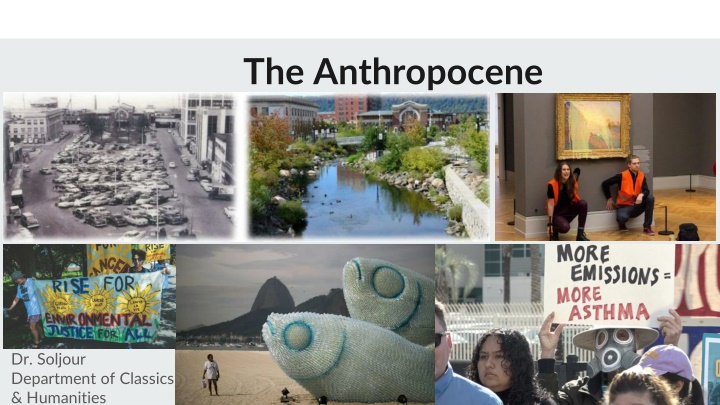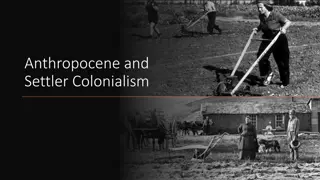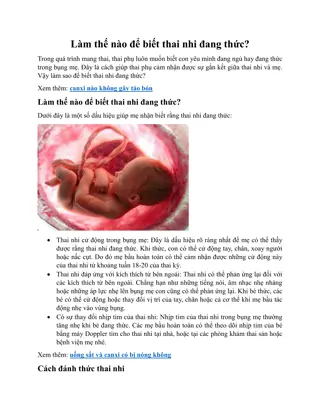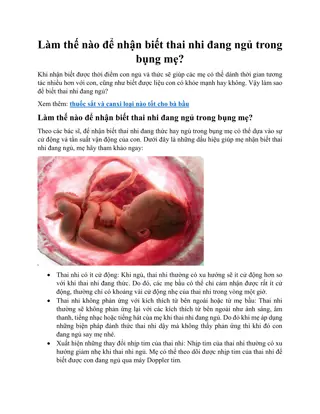The Anthropocene
This content delves into the Anthropocene era, examining human activities' effects on Earth's ecosystems. It discusses environmental movements, legislating for the environment, and the link between the Anthropocene and climate change. The text highlights key moments in the modern environmental movement in the United States and the legislative changes that followed. Furthermore, it explains the evolving understanding of humanity's role in shaping the Earth's future, emphasizing the importance of global ethics in addressing the challenges posed by the Anthropocene.
Download Presentation

Please find below an Image/Link to download the presentation.
The content on the website is provided AS IS for your information and personal use only. It may not be sold, licensed, or shared on other websites without obtaining consent from the author.If you encounter any issues during the download, it is possible that the publisher has removed the file from their server.
You are allowed to download the files provided on this website for personal or commercial use, subject to the condition that they are used lawfully. All files are the property of their respective owners.
The content on the website is provided AS IS for your information and personal use only. It may not be sold, licensed, or shared on other websites without obtaining consent from the author.
E N D
Presentation Transcript
The Anthropocene Dr. Soljour Department of Classics & Humanities
Lecture What is the Anthropocene? Environmental Movements in the United States Legislating the Environment Protesting Climate Change Ecological Art Overview
The Anthropocene & Climate Change The Anthropocene is an informal geologic chronological term that examines the evidence and extent of human activities on Earth s ecosystems. These kinds of human activity disrupted the Earth System beyond merely altering the landscape or interfering in the ecosystem. The concept emerged out of Earth System science in the 1980s and 1990s but was embraced by humanities scholars in the 2000s. The collaboration between scientists and humanists resulted in research that examines the contemporary period as one of the highest concentration of pollutants released during the 1950s. These pollutants include inorganic and organic compounds that have been widely studied in sediments such as: aluminum, lead, plutonium, and microplastics. This crisis of the Anthropocene, focuses on global ethics. By tracing the contributions of conservatism, environmentalism, and apocalypticism to the Anthropocene. Welcome to the Anthropocene A 3-minute journey through the last 250 years of our history, from the start of the Industrial Revolution to the Rio+20 Summit. The film charts the growth of humanity into a global force on an equivalent scale to major geological processes. The film was commissioned by the Planet Under Pressure conference, London 26-29 March, a major international conference focusing on solutions. planetunderpressure2012.net The film is part of the world's first educational webportal on the Anthropocene, commissioned by the Planet Under Pressure conference, and developed and sponsored by anthropocene.info
Environmental Movements in the United States Within the United States, the modern environmental movement began receiving national support in the 1960s. In the 1960s, citizens became increasingly concerned about air and water pollution. Ten years later, in the spring of 1970, Senator Gaylord Nelson created Earth Day as a way to call attention to the deterioration of our environment and the mindless dissipation of our resources. 20 million Americans demonstrated in cities across the United States. In December 1970, Congress authorized the creation of a new federal agency to tackle environmental issues, the U.S. Environmental Protection Agency. In the 1980s, the Sustainability movement focused on the relationship between science and and human responsibility. California became an industry leader in sustainable living. This way of life aims at the reduction of an ecological footprint: focusing on home designs, means of transportation, energy consumption and diet. In the late 1980s/1990s, the environmental justice movement began in urban and rural communities within the United States. This movement focuses on environmental racism. Many low-income and minority communities are located close to highways, garbage dumps, and factories, where they are exposed to greater pollution and environmental health risk than the rest of the population. Flint Michigan Water Crisis L.A. s EcoVillage
Legislating the Environment Before 1970, the protection of basic air and water supplies was a matter mainly left to each state. During the 1970s, the primary responsibility for clean air and water shifted to the federal government. Growing concerns, both environmental and economic, led to the passage of extensive legislation including: The 1970 National Environmental Policy Act (NEPA), which established the Council on Environmental Quality. The Clean Air Act of 1970: resulted in a major shift in the federal government's role in air pollution control. This legislation authorized the development of comprehensive federal and state regulations to limit emissions from both stationary (industrial) sources and mobile sources. With 66.9 percent less pollution, Americans are living healthier, longer lives. Thanks in large part to the Clean Air Act, have added 1.3 years to the life expectancy of the average American since 1970. The Water Pollution Control Act Amendments of 1972: established the basic structure for regulating pollutant discharges into the waters of the United States. It gave the government the authority to implement pollution control programs such as setting wastewater standards for industry. These laws regulated public drinking water systems, toxic substances, pesticides, and ocean dumping; and protected wildlife, wilderness, and wild and scenic rivers. These new laws also provided support for pollution research, standard setting, contaminated site cleanup, monitoring, and enforcement. This led to a major shift in the environmental movement. Environmental groups shifted their focus from local issues to becoming a lobby in Washington. Environmentalists became much more influential in American politics as a result of this legislation.
Environmental Justice for All Bill The Environmental Justice For All Act was created to fight environmental racism. The first of its kind, the act provide more resources for citizens. This bill establishes several environmental justice requirements, advisory bodies, and programs to address the disproportionate adverse human health or environmental effects of federal laws or programs on communities of color, low-income communities, or tribal and indigenous communities. In order to accomplish these goals: Agencies would have to provide impact reports and safer alternatives to some consumer products. Funding would be provided for parks in urban areas. Over 300 organizations and 100 co-sponsors supported the bill. Many organizations in support of this legislation represent 2 vulnerable communities: Fence Line Communities and Sacrifice Zones. A Fence Line Community lives adjacent to highly polluting facilities. These communities are in close proximity to: fossil fuel infrastructure, industrial parks, large manufacturing facilities and are directly affected by traffic, noise, operations, chemical and fossil fuel emissions. Within San Diego: Barrio Logan is a highly visible fence line community. A Sacrifice Zone: is a geographic location where cancer rates caused by air pollution exceed the US government s own limit of acceptable risk. Around a quarter of a million Americans live in these zones. The Environmental Justice For All Act was introduced on July 27, 2022, but did not receive enough votes. A Fence Line Community in Pennsylvania Image Credit: ProPublica Sacrifice Zones
Question: How much for time can we give? Barrio Logan, San Diego: A Fence Line Community Barrio Logan was established in the 1900s by predominantly migrants arriving from Mexico to work as laborers, cannery workers, welders, pipefitters, and longshoremen. After World War II, San Diego rezoned Barrio Logan to allow polluting industries, junkyards, metal plating shops, and other toxic businesses into the neighborhood. In the mid-1960s, the community was divided by the construction of Interstate 5. It split Logan into Barrio Logan and Logan Heights, destroying hundreds of homes and displacing many lifelong residents. In 1967, the Coronado Bridge was built through Barrio Logan causing more destruction and displacement. The community protested for Chicano Park to be created under the bridge instead of a highway patrol station. Due to Barrio Logan s proximity to the navy shipyard, an oil-processing center, military zones and heavy traffic, residents are exposed to high levels of toxic pollutants. Including Black Carbon, Ozone, and Nox and fine particulate matter. As a result, residents have higher rates of asthma and other respiratory illnesses. The California Environmental Protection Agency found that Barrio Logan residents had an asthma hospitalization rate higher than 92.9% of zip codes across California. The asthma hospitalization rate is around 2.5 times that of the national average. Barrio Logan is recognized as a fence line community. In response to these issues, neighborhood activists, SDSU professors, community leaders proposed the following solutions. The Barrio Logan Community Plan aimed aimed to create a nine-block buffer zone that would separate the Navy shipyard from homes, The first iteration of this proposition failed, in part because the plan was opened to voters outside of Barrio Logan. A second solution to address high asthma rates did succeed. The Intersectional Health Project San Diego (IHPSD) developed a system that would provide emergency power for asthma-directed medical devices for days when the residents can not pay for electricity. How air pollution is disproportionately impacting minority communities in San Diego There is new evidence about the disproportionate impact of air pollution in this country. A study out this week from the University of California, San Diego shows that California's environmental regulations have systematically protected the state's white residents over people of color. Amna Nawaz reports on one community in San Diego grappling with the best path forward. Stream your PBS favorites with the PBS app: https://to.pbs.org/2Jb8twG Find more from PBS NewsHour at https://www.pbs.org/newshour Subscribe to our YouTube channel: https://bit.ly/2HfsCD6 Follow us: Facebook: http://www.pbs.org/newshour Twitter: http://www.twitter.com/newshour Instagram: http://www.instagram.com/newshour Subscribe: PBS NewsHour podcasts: https://www.pbs.org/newshour/podcasts Newsletters: https://www.pbs.org/newshour/subscribe
Question: What is worth more: art or life? Art destruction in the name of political or social change can be traced back to antiquity! Last year, climate activists protested the global environmental crisis by targeting internationally renowned art museums. 13 pieces of art in museums around the world (England, Australia, Sweden, Italy, France, Netherlands, Canada, Spain, Norway) were defaced. In the case of Just Stop Oil: The founder switched protest tactics when the group did not get much attention from blockading oil terminals, an action that is explicitly tied to their goals. None of the works targeted had lasting damage as many are covered by glass. Activists are targeting these famous works not to destroy them, but to draw media attention to the lasting damage of the climate crisis. A Time Magazine survey examined the effects of these non-violent, disruptive actions. Younger respondents (aged 18 to 29) were less likely to decrease their support to address climate change compared to the oldest (aged 65 and over) respondents. However, all age groups showed decreased support for the movement. In response to these protests, UK Prime Minister Rishi Sunak signed the new Public Order Bill, which would punish the act of gluing oneself to objects or buildings, or blocking transport by six months in prison. Protesting Climate Change Why activists are targeting famous art to protest climate change Over the past few months, activists have targeted priceless works of art to call attention to the climate crisis. These viral moments are grabbing attention, but is the message getting through? We look at how these protests could be both helping and hurting in the fight against climate change. Stream your PBS favorites with the PBS app: https://to.pbs.org/2Jb8twG Find more from PBS NewsHour at https://www.pbs.org/newshour Subscribe to our YouTube channel: https://bit.ly/2HfsCD6 Follow us: Facebook: http://www.pbs.org/newshour Twitter: http://www.twitter.com/newshour Instagram: http://www.instagram.com/newshour Subscribe: PBS NewsHour podcasts: https://www.pbs.org/newshour/podcasts Newsletters: https://www.pbs.org/newshour/subscribe Extinction Rebellion: uses nonviolent civil disobedience to compel government action in the climate system. Stop Fossil Fuel Subsidies: use various tactics to halt any new fossil fuel projects in the UK. Last Generation: aim to combat climate changes by blocking various roads & highways. Last year, protesters conducted 276 road blockades in Germany.
Question: How do you move people past their fatigue and grief, and galvanize action? Ecological art is a genre and artistic practice that seeks to preserve and vitalize the resources of Earth. It also addresses politics, culture, economics, ethics and aesthetics as they impact the conditions of ecosystems. Practitioners include artists, scientists, philosophers and activists who often collaborate on restoration, remediation and public awareness projects. Ecological Art Artists within this field adhere to the following principles: 1. Focus on the web of interrelationships in our environment on the physical, biological, cultural, political, and historical aspects of ecological systems. Create works that employ natural materials or engage with environmental forces such as wind, water, or sunlight. Reclaim, restore, and remediate damaged environments. Inform the public about ecological dynamics and the environmental problems we face. Revise ecological relationships, creatively proposing new possibilities for coexistence, sustainability, and healing. In Unhappily Ever After Jeff Hong integrates famous Disney characters into realist situations of environmental degradation. 2. 3. 4. 5. In NY Trash a Treasure Stephanie Smith uses plastic bottles to discuss water pollution, access to clean water and sustainability practices.
Richard McGuires Here Questions to Consider: How do our everyday activities impact the environment? Who should be accountable for protecting the environment? What role does time play in tracking human activity?























